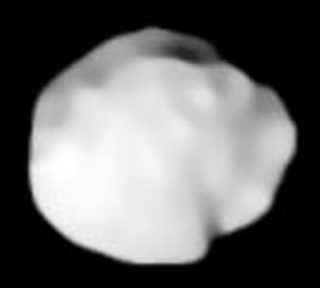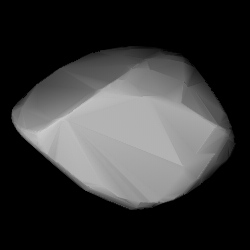Related Research Articles

An asteroid is a minor planet—an object that is neither a true planet nor a comet—that orbits within the inner Solar System. They are rocky, metallic, or icy bodies with no atmosphere. The size and shape of asteroids vary significantly, ranging from small rubble piles under a kilometer across to Ceres, a dwarf planet almost 1000 km in diameter.

Johann Elert Bode was a German astronomer known for his reformulation and popularisation of the Titius–Bode law. Bode determined the orbit of Uranus and suggested the planet's name.

Frederick William Herschel was a German-British astronomer and composer. He frequently collaborated with his younger sister and fellow astronomer Caroline Herschel. Born in the Electorate of Hanover, William Herschel followed his father into the military band of Hanover, before emigrating to Great Britain in 1757 at the age of nineteen.

Pallas is the third-largest asteroid in the Solar System by volume and mass. It is the second asteroid to have been discovered, after Ceres, and is a likely remnant protoplanet. Like Ceres, it is believed to have a mineral composition similar to carbonaceous chondrite meteorites, though significantly less hydrated than Ceres. It is 79% the mass of Vesta and 22% the mass of Ceres, constituting an estimated 7% of the mass of the asteroid belt. Its estimated volume is equivalent to a sphere 507 to 515 kilometers in diameter, 90–95% the volume of Vesta.

The asteroid belt is a torus-shaped region in the Solar System, centered on the Sun and roughly spanning the space between the orbits of the planets Jupiter and Mars. It contains a great many solid, irregularly shaped bodies called asteroids or minor planets. The identified objects are of many sizes, but much smaller than planets, and, on average, are about one million kilometers apart. This asteroid belt is also called the main asteroid belt or main belt to distinguish it from other asteroid populations in the Solar System.

Giuseppe Piazzi was an Italian Catholic priest of the Theatine order, mathematician, and astronomer. He established an observatory at Palermo, now the Osservatorio Astronomico di Palermo – Giuseppe S. Vaiana. He is perhaps most famous for his discovery of the first dwarf planet, Ceres.

Juno is a large asteroid in the asteroid belt. Juno was the third asteroid discovered, in 1804, by German astronomer Karl Harding. It is one of the twenty largest asteroids and one of the two largest stony (S-type) asteroids, along with 15 Eunomia. It is estimated to contain 1% of the total mass of the asteroid belt.

Caroline Lucretia Herschel was a German-born British astronomer, whose most significant contributions to astronomy were the discoveries of several comets, including the periodic comet 35P/Herschel–Rigollet, which bears her name. She was the younger sister of astronomer William Herschel, with whom she worked throughout her career.

Astronomical symbols are abstract pictorial symbols used to represent astronomical objects, theoretical constructs and observational events in European astronomy. The earliest forms of these symbols appear in Greek papyrus texts of late antiquity. The Byzantine codices in which many Greek papyrus texts were preserved continued and extended the inventory of astronomical symbols. New symbols have been invented to represent many planets and minor planets discovered in the 18th to the 21st centuries.
Piero Sicoli is an Italian astronomer and discoverer of minor planets, observing at the Italian Sormano Astronomical Observatory. As the observatory's coordinator, he is responsible for close encounters computation of near-Earth objects (NEOs), orbit computations, and identification of asteroids. The Observatory's focus is the examination and tracking of NEOs in Solar System.
The definition of the term planet has changed several times since the word was coined by the ancient Greeks. Greek astronomers employed the term ἀστέρες πλανῆται, 'wandering stars', for star-like objects which apparently moved over the sky. Over the millennia, the term has included a variety of different celestial bodies, from the Sun and the Moon to satellites and asteroids.

1000 Piazzia, provisional designation 1923 NZ, is a carbonaceous background asteroid from the outer region of the asteroid belt, approximately 48 kilometers in diameter. It was discovered on 12 August 1923, by German astronomer Karl Reinmuth at Heidelberg Observatory in southern Germany. The C-type asteroid has a rotation period of 9.5 hours. It was named after Italian Giuseppe Piazzi, who discovered 1 Ceres.

Ceres is a dwarf planet in the middle main asteroid belt between the orbits of Mars and Jupiter. It was the first known asteroid, discovered on 1 January 1801 by Giuseppe Piazzi at Palermo Astronomical Observatory in Sicily, and announced as a new planet. Ceres was later classified as an asteroid and then a dwarf planet, the only one always inside Neptune's orbit.

1002 Olbersia is a background asteroid from the central regions of the asteroid belt. It was discovered on 15 August 1923, by Russian astronomer Vladimir Albitsky at the Simeiz Observatory on the Crimean peninsula. The assumed C-type asteroid has a rotation period of 10.2 hours and measures approximately 24 kilometers in diameter. It was named after German astronomer Heinrich Olbers (1758–1840).
2000 Herschel, provisional designation 1960 OA, is a stony Phocaea asteroid and a tumbling slow rotator from the inner regions of the asteroid belt, approximately 16 kilometers in diameter. It was discovered 29 July 1960, by German astronomer Joachim Schubart at Sonneberg Observatory in eastern Germany. The S-type asteroid has a long rotation period of 130 hours. It was named after astronomer William Herschel.
4276 Clifford, provisional designation1981 XA is an asteroid and sizable Mars-crosser from the innermost region of the asteroid belt, approximately 4.4 kilometers in diameter. It was discovered on 2 December 1981, by American astronomers Edward Bowell at Lowell Observatory in Flagstaff, United States. The asteroid was named in honor of astronomer and writer Clifford Cunningham.
Phaeton was the hypothetical planet hypothesized by the Titius–Bode law to have existed between the orbits of Mars and Jupiter, the destruction of which supposedly led to the formation of the asteroid belt. The hypothetical planet was named for Phaethon, the son of the sun god Helios in Greek mythology, who attempted to drive his father's solar chariot for a day with disastrous results and was ultimately destroyed by Zeus.
3000 Leonardo, provisional designation 1981 EG19, is a carbonaceous background asteroid from the inner regions of the asteroid belt, approximately 9.5 kilometers (5.9 miles) in diameter. It was discovered on 2 March 1981, by American astronomer Schelte Bus at the Siding Spring Observatory in Australia. The B-type asteroid has a rotation period of 7.5 hours. It was named for the Italian polymath Leonardo da Vinci.

Historical models of the Solar System began during prehistoric periods and are updated to this day. The models of the Solar System throughout history were first represented in the early form of cave markings and drawings, calendars and astronomical symbols. Then books and written records became the main source of information that expressed the way the people of the time thought of the Solar System.
The Celestial police, officially the United Astronomical Society, was a cooperation of numerous European astronomers in the early 19th century. It is mainly known in relation to the search for objects expected between the orbits of Mars and Jupiter. It was formed in 1800 at the second European congress of astronomers. At the first such congress, in 1798, the French mathematician Jérôme Lalande had called for a coordinated search, in which each participating observatory would patrol a particular part of the sky. The group confirmed or discovered the four largest minor planets, which would lead to the identification of the asteroid belt. They also initiated the compilation of better star catalogues and the investigation of variable stars. They pioneered international collaboration and communication in astronomy.
References
- 1 2 3 Schmadel, Lutz D. (2007). "(4276) Clifford". Dictionary of Minor Planet Names – (4276) Clifford. Springer Berlin Heidelberg. p. 366. doi:10.1007/978-3-540-29925-7_4236. ISBN 978-3540299257.
- ↑ "The Life and Achievements of a UWaterloo Astronomer". Alumni. 27 November 2015. Retrieved 15 April 2019.
- ↑ "Clifford Cunningham". Encyclopedia Britannica. Retrieved 15 April 2019.
- ↑ Where Did the Word Asteroid Really Come From?, Smithsonian Magazine Blog, October 10, 2013.
- ↑ "MPC/MPO/MPS Archive". Minor Planet Center. Retrieved 15 June 2017.
- ↑ Cunningham, Clifford (2004). "Discovery of the Missing Correspondence between Carl Friedrich Gauss and the Rev. Nevil Maskelyne (1802–5)". Annals of Science. 61 (4): 469–481. doi:10.1080/00033790310001660164. S2CID 144853677.